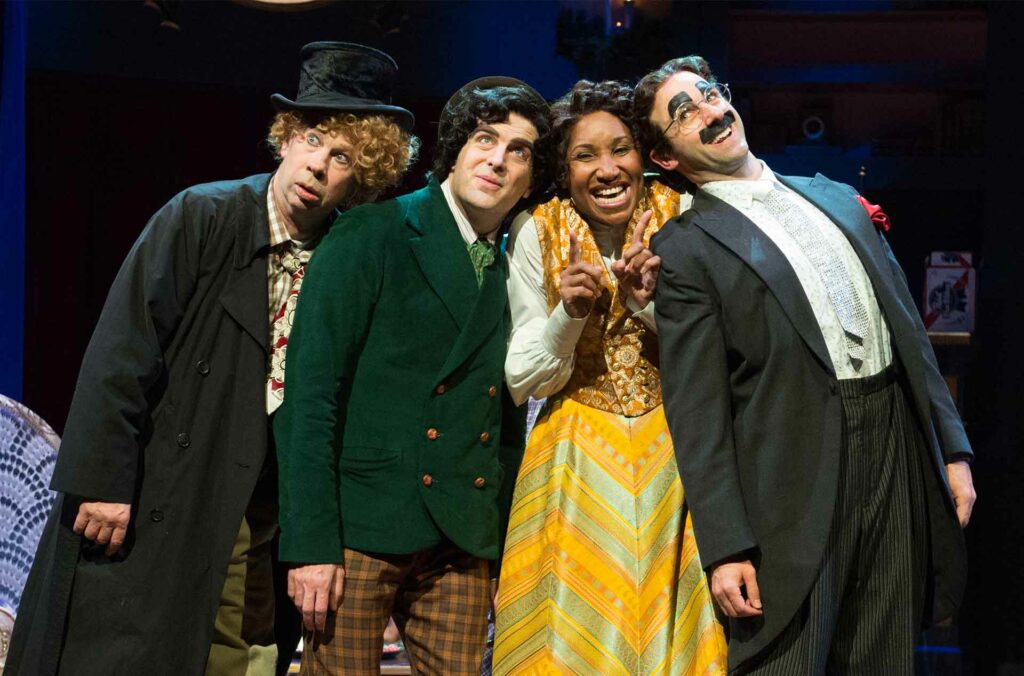Brent Hinkley, John Tufts, Safiya Fredericks, Mark Bedard. Image Credit Jenny Graham, Oregon Shakespeare Festival
Before winter break, I had the absolute pleasure of seeing one of the Oregon Shakespeare Festival’s newest shows (and first holiday-themed show), “It’s Christmas, Carol!”. Like many, I haven’t gone to the festival since the pandemic, and I wanted to do something special to celebrate the the Ashland staple being open again. It’s Christmas, Carol! is written by long-time OSF actors Mark Bedard (“A Wrinkle in Time,” “A Midsummer Night’s Dream”), Brent Hinkley (“Peter and the Starcatcher,” “Bernthardt/Hamlet”), and John Tufts (“Antony and Cleopatra,” “Head Over Heels”). It follows Carol Scroogenhouse (played by Kate Mulligan, “Hairspray”), a shrewd businesswoman who is haunted by three spirits (played by Bedard, Hinkley, and Tufts) and learns the true meaning of the holiday spirit along the way.
The audience could not stop laughing throughout the show. The humor ranged from cultural and topical to even visual. Everyone, particularly Bedard, Tufts, and Hinkley (who played the Ghosts of Holidays Past, Present, and Future) had great comedic chemistry and played off each other very well. Kate Mulligan played a fantastic Scrooge (or Scroogenhouse) and her performance reminded me of Catherine O’Hara’s Moira Rose in “Schitt’s Creek”. Most importantly, everyone on stage was having a fun time, and it was such a joy to watch and witness.
After watching the play, I wanted to know more about the story and what it was like directing a show like this during the pandemic. I was delighted to be able to interview Pirronne Yousefzadeh, the director of “It’s Christmas, Carol!”. During our interview, Pirronne had amazing insight regarding directing a show of this scale to creating a holiday show that was accessible and inclusive to all, to even describing her favorite thing about Ashland.
Right off the bat, one of the things that Pirronne says attracted her to the Oregon Shakespeare Festival was the legacy of the festival itself. “OSF has been on my bucket list of theatres that I wanted to work at since I knew I wanted to be a director,” Pirronne said. “Just as a foundation it was always a dream place to work.” In terms of what drew her to “It’s Christmas, Carol!” specifically was a multitude of elements: the main one being the play’s subject matter. “As a Middle Eastern director, I’m not often asked to do the big holiday spectacular, and I love directing comedy and I love directing musicals, and the play is sort of a combination of both.”
She also offered a compelling glimpse into the world of directing for the theatre. “Directors can often be cast based on race or other aspects of their identity, to then direct particular types of plays. So if felt like a real opportunity to delve into the kinds of aesthetics and genres that I really enjoy and really enjoy directing in…[this play] it was an amazing opportunity on every level, both because of the institution and also because the project checked so many boxes of the kind of theatre I wanted to make, and the joy I find in working on that type of play.”
With all of the different moving parts of the play, from the technical aspects like lights and sound, to the musical numbers, to even the comedic timing of the actors, I asked Pirronne what the most difficult aspect of directing the show was. “Probably the circumstances we find ourselves in currently, because the pandemic is not over, and that means a lot of the community aspects of theatre that one takes for granted are off-limits because we have to keep each other safe,” she said. Things that were normal and common practice before the pandemic are now much riskier, like sharing a rehearsal room together.
However, she’s still grateful for the people who helped bring this show to life. “As I often told the whole team, we had difficult circumstances and incredible people, and I will always take that over incredible circumstances with difficult people.” Being able to create art with others and being able to see everyone support one another was one of the things that made the show really rewarding for Pirronne. “Because of that, it made those challenges in some way pale in comparison to the remarkable perseverance and heroism of the artists involved who did everything and then some in order to make this play still happen, despite everything we were still navigating.”

Building a community and spreading joy through the power of theatre were incredibly important to Pirronne when helping create this play, and she even says so in the director’s notes of the show. Wanting everyone to feel like they had a voice was one of her goals. “I entered into this feeling like an outsider to the holiday show experience, both as a child of Iranian immigrants and also as a Jewish person. I haven’t seen a holiday show that I felt represented any aspects of my identity or any identity other than a White Christian experience,” she said. “Very early on in the process of working with the writers, we talked about how we wanted this show to democratize the holiday show experience.” Pirronne states that if holiday shows want to be more accessible and relatable to all who see them, then that means that both the story and the people onstage “have to be representative of the multiplicity of identities of the world in which we live…we had a mission that that was about centering and including people for whom might have shared my feeling of being an outsider to this kind of tradition.”
Another one of her favorite things about working on this show was the community behind the curtain. Aside from getting to work on a new play and being able to be back to working in-person, the collaboration backstage was what made this play special to her. “Not only the cast, but also the stage management team, the designers, our choreographer, our composer/arranger, dramaturg, my assistant director; I could go on and on about how many remarkable people I felt very fortunate to be working with.”
I always love talking about the technical aspects of theatre, especially those who worked backstage, and the stagehands in this show really shone. They essentially were their own characters, pushing and pulling props and sets from the stage with gusto and flair. As you watched the show, you had the sense that everyone was having fun telling this story, both onstage and off.
With a new play, there are constant changes that have to be made, even up to opening night. Despite the edits, Pirronne credits the cast for being so insightful in regards to the development of a new play. “They offered the questions and ideas over the course of the rehearsal process that I think also helped shape the play and the written word on the page just as much as they shaped their own performances on stage…what I think we ultimately experienced was an extremely collaborative, organic process.” She specifically praised the three writers of the play, who were able to flawlessly switch “between their writer hat and their actor hat” while they were working on the play.
Lastly, the play holds another special meaning for her: it was her second production since the theatre was allowed to reopen. Doing something of this scale after twenty months of isolation was really gratifying for her. Speaking from experience, I know how hard it can be to be creative and functional completely online. You’re already using so much energy to try and stay focused for the next task, so using more of that energy for creativity can be trying. For Pirronne, “it was great to come back with a show that was coming back with a bang, it was coming back with something big and fun and loud and wacky and in itself joyous to create.” Working on this show was incredibly restorative for her “to come back to a project that demanded full theatricality and wanted all of us to sort of break our funniest, most creative, zaniest selves…in a lot of ways I felt like it sort of shook the cobwebs off of me directorially and also brought me back in touch with my own sense of humor as a director which I had felt a little less connected to during the pandemic.”
When asked about her favorite thing about Ashland, Pirronne responded saying that Ashland’s natural beauty was something she really appreciated. “On the days that I had time, I would go take a walk and look at Lithia Park, or I would walk around town and just appreciate its quaintness and the fall foliage.” The weather was another thing that she loved about Ashland, since the weather was much milder than compared to her previous city of Rochester, NY.
Pirronne has a lot planned in terms of what’s next after “It’s Christmas, Carol!”. She was recently appointed the Producing Artistic Director of the Colorado Springs Fine Arts center at Colorado College, and said she is looking forward to planning their next season. She is also planning on directing two plays in the spring, “Yoga Play” by Dipika Guha and “Heartland” by Gabriel Jason Dean. “You know, every time I feel a little stressed, I also remind myself that this is exactly what I was missing for so long. It’s an embarrassment of riches, and I’m just grateful for the work and grateful to get to tell stories again in the medium that I enjoy most,” she said after a moment of thought.
“It’s Christmas, Carol!” is running at the Oregon Shakespeare Festival from November 23rd, 2021 to January 2nd, 2022 at the Angus Bowmer Theatre. Tickets and more info on the show can be found here.



